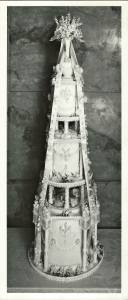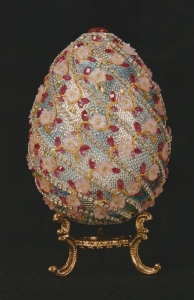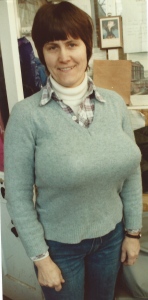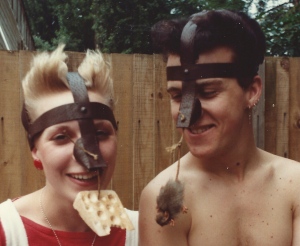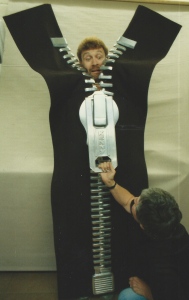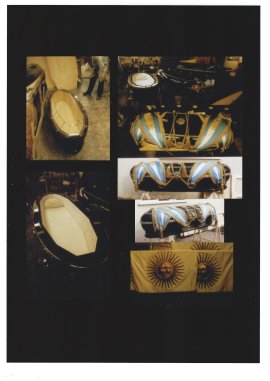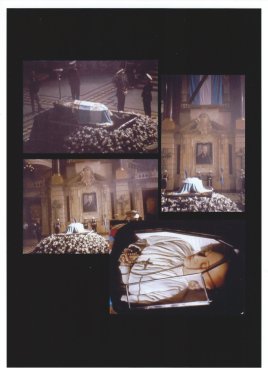Louise writes – One of the most enjoyable processes for me when making props was sourcing the materials.  In the beginning I would go to London to companies that specialised in various products. Novelty Imports in Regent Street (no longer there) sold beautiful flowers. I could purchase anything from full-blown silk roses, perfect primroses, forget-me-nots, violets and cherry blossom, to flower stamens. When we were commissioned to make a replica of a period wedding cake for the newly opened Museum of London in 1976.
In the beginning I would go to London to companies that specialised in various products. Novelty Imports in Regent Street (no longer there) sold beautiful flowers. I could purchase anything from full-blown silk roses, perfect primroses, forget-me-nots, violets and cherry blossom, to flower stamens. When we were commissioned to make a replica of a period wedding cake for the newly opened Museum of London in 1976.
I bought the most beautiful wax flowers which were ‘old stock’ and probably the last of those types available. I always bought some extras just in case they were needed for some future prop. To visit John’s wonderful showroom was like being in a flower market, only the blooms never faded. I would buy ribbons from H V Caldicott, at that time in Berners Street W1. The West End showroom was comprised of brown card boxes full of ribbons, stacked to almost ceiling height. Narrow corridors between the boxes led to the office where I would find Barry surrounded by sample cards and paperwork. It did not matter how small the purchase, he was always helpful and when I no longer went to see him in person, he would send samples, then rolls of ribbon, by post. In 1995 I purchased four rolls of silver voile ribbon, which was made is Switzerland, for Evita’s coffin dais, this was sown onto a black velvet drape. Forty metres at £4.00 per metre plus VAT!
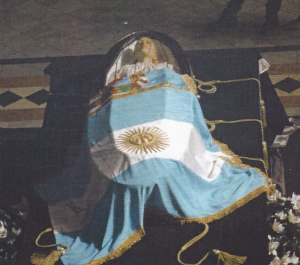
Evita’s coffin with Marocain silk flag, tassels and silver voile ribbon – just visible on the right as is Madonna.
The tassels which hung from Evita’s coffin came from Henry Newbery of Mortimer Street, who sold the most beautiful cords, braids, tassels and gold metallic trimmings, which came in three different widths and were used to embellish so many props throughout our forty-one years. I still have some precious pieces at home in a glass-fronted drawer cabinet. Gold cords and metallic braids I purchased from Hand and Co (now Hand & Lock) who were embroiderers of decorations for uniforms and flags etc. It was unusual to be able to purchase from them, but the lady manageress always sold me wired gold trim which looked like miniature springs. I used these for my decorations to wind around cinnamon sticks. When I was at the Central School of Art in the 1960’s I was sent to Balfours in Shoreditch to purchase feathers from a Miss Rhule. Years later, when she had moved to the attic room of a house behind Regent Street, I would climb the stairs, the conditions getting more and more decrepit with each floor, until I reached a room with a water stained ceiling, full of bags and boxes of myriad feathers. Miss Rhule would sit, curling ostrich feathers for headdresses, in a cloud of steam from the spout of her special kettle. She made all the wonderful feather boas for West End shows, and always lamented the fact that no one was interested in learning her skills, I would have loved to, but never had the time. It always amused me that she would feed the pigeons, who would march around her room amongst the feathers of their near and faraway cousins. Miss Rhule would always go on an exotic holiday in January after the Christmas Pantomime rush. She certainly deserved it. Another favourite supplier was A E Ward in Clerkenwell (now in Hatton Garden). I had to make a Faberge style egg for a Sony commercial and needed ‘diamonds’ and ‘rubies’. The stones were no problem, marquis or navette cut garnets were perfect, as were the small ‘diamonds’ mounted in strips with which I hid the joins in the hologram fabric that covered the basic egg shape. I asked Len if by any chance he had any small pink blossom flowers? Off he went into the depth of his stock room and returned with the perfect quartz flowers.
‘How many do you need?’ ‘About three dozen.’ The box contained exactly the right number. Phew. On another occasion we had to make a replica of the Imperial State Crown for the film ‘King Ralph’. Yet again Len was able to supply all the synthetic stones we required, and over the years, many others. Nothing was ever too much trouble and often he would post me items on approval. Where did I buy the hologram fabric for the egg? In Berwick Street, Soho, at a wondrous shop called Borovicks. Yards of fabric spilled out of the door onto the market stall in the road, a preview of what could be found inside. Plain and striped cottons, satins, silks, velvets, jersey, suiting, PVC, stretch Lycra, reptile prints, gold, silver and coloured lame, hologram prints and so much more – a joy to behold. Although I always relished the hunt for different materials, there came a time when I had to rely on others to do the buying for me. Initially Karin, Keir’s sister
– who carried on working for us for twenty-one years as workshop manager – then Fay, a bubbly redhead, as tenacious as anyone could wish for in a buyer, followed by Jill, who could charm anything out of anyone. Her daughter,
Sarah also worked with us from the age of sixteen – a stroppy teenager with pink Mohican hairdo and Lonsdale boxing boots – till she left eighteen years later, an accomplished graphics designer. Finally, David, who initially supplied us with paints and other materials from his shop in Shepperton High Street. Always very efficient, he loved working in a busy film studio and could be relied on to know what films were being made and as a result he was the best person to show visitors around the studio.
He worked with us until, much to his disappointment, we were forced to close in 2011.
